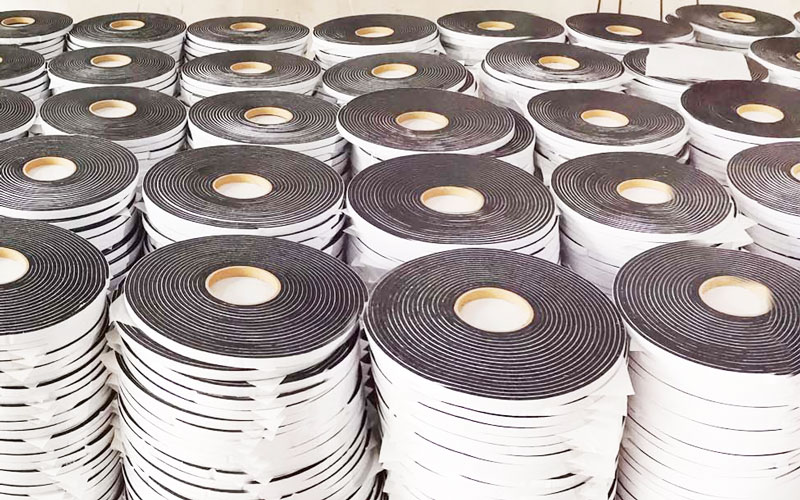In the fields of building decoration, home decoration and daily window maintenance, correctly sticking foam tape to windows is a vital task. It is not only related to the sealing performance and sound insulation of the window, but also affects the overall beauty and comfort. Here Shanghai Toptape-professional foam tape manufacturer will tell you in detail how to apply foam tape to windows, to ensure that you can get the best sticking effect and improve the use experience of the window.

1. Preparation
Material inspection
- First, make sure that the quality of the foam tape meets the requirements. Check whether the tape is damaged, deformed or expired. High-quality foam tape should have good elasticity, stickiness and weather resistance.
- The thickness and width of the foam tape should be selected according to the specific purpose and size of the window. For example, for windows with higher sealing performance requirements, you may need to choose a thicker foam tape; for narrow window frame gaps, you should choose a tape with a suitable width to ensure the sticking effect.
Tool preparation
- Cleaning tools: Prepare a clean rag or a special detergent to clean the window surface. The cleaning agent should be a product that will not corrode the window material (such as glass, aluminum alloy or plastic steel of the window frame, etc.).
- Cutting tools: such as sharp utility knives or scissors, are used to cut the foam tape. Make sure the blade of the tool is sharp so that a neat edge of the tape can be cut.
- Auxiliary tools: If necessary, prepare a roller tool. The roller can help compact the tape and remove the air between the tape and the window surface, making the paste more secure.
Surface treatment - Cleaning the window: Dip a clean rag in the cleaning agent and wipe the window surface carefully. For the glass part, remove dust, oil stains, water stains, etc.; for the window frame part, also pay attention to cleaning the debris in the gap. After cleaning, wipe the window surface with a clean dry rag to ensure that the surface is completely dry.
- Sanding (if necessary): If the window surface is too smooth, it may affect the stickiness of the foam tape. In this case, you can use fine sandpaper to gently sand the window surface to increase the surface roughness, but be careful not to scratch the window. After sanding, clean the surface again to remove the dust generated by sanding.
2. Pasting process
Tape cutting
- Accurately measure and cut the foam tape according to the size of the window and the shape of the pasting part. When cutting, reserve a certain length, generally 5-10% more than the actual length required, to prevent the length from being insufficient during the pasting process.
- For corners or curved windows, try to cut the tape into a suitable shape. Bevel or arc cutting can be used to make the tape fit the contour of the window better.
Pasting operation
- Remove the adhesive backing of the tape: Starting from one end of the tape, carefully peel off a small section of the adhesive backing paper, and be careful not to let the tape stick to itself. Align the end of the adhesive backing to the starting position of the window pasting part.
- Paste starting end: Gently press the starting end of the tape on the window surface to ensure that the tape fits tightly to the window to avoid bubbles or gaps. You can press from the center of the tape to the edge to make the tape stick evenly on the window.
- Paste while peeling the adhesive backing: Slowly peel off the adhesive backing paper and gradually stick the tape along the window pasting part. During the pasting process, keep the tape in a proper stretching state to avoid deformation or loss of adhesiveness caused by excessive stretching, and do not make it too loose to avoid wrinkles.
- Corner and edge treatment: When encountering the corner of the window, gently bend the tape to fit the shape of the corner. You can use a roller tool to gently roll at the corner to make the tape fit better. For the edge of the window, make sure that the tape completely covers the edge and fits tightly with the edge to achieve a good sealing effect.

Compact the tape
- Use the roller tool: After the entire tape is pasted, use the roller tool to roll and compact from one end of the tape to the other end. When rolling, apply appropriate pressure to make the tape fully contact with the window surface and exclude air. You can roll back and forth several times, especially at the edges and corners of the tape, and focus on compacting.
- Manual compaction: If there is no roller tool, you can also use your fingers or a soft scraper instead. Use your fingers or scraper to squeeze from the center of the tape to the edge to compact the tape. But pay attention to the cleanliness of your fingers or scraper to avoid contaminating the surface of the tape.
3. Inspection and maintenance after pasting
Check the pasting effect
- Appearance inspection: Check whether the tape is pasted flatly and whether there are bubbles, wrinkles or gaps. If bubbles are found, you can use a needle or a sharp tool to poke a small hole in the bubble, and then use your fingers or a roller tool to squeeze out the air to make the tape fit again.
- Viscosity inspection: Check whether the tape is sticky enough within a period of time after pasting (such as within 24 hours). You can gently pull the edge of the tape by hand to check if there are signs of looseness. If the stickiness is found to be insufficient, it may be that the surface cleaning is not thorough during the pasting process or the quality of the tape itself is a problem, and it needs to be re-pasted in time.
Maintenance suggestions
- Avoid contact with sharp objects: In daily use, avoid contact between the foam tape on the window and sharp objects to avoid scratching the tape and affecting the sealing and pasting effect.
- Regular cleaning: When cleaning windows regularly, be careful not to use too strong detergents or tools to scratch the surface of the tape. You can use a mild detergent and a soft cloth to gently wipe the window part around the tape.
- Environmental factors: If the window is in harsh environmental conditions, such as high temperature, high humidity or strong acid and alkali environment, check the status of the tape regularly. Because these environmental factors may affect the performance of the tape, if necessary, the tape should be replaced in time.

Through the above comprehensive and meticulous steps, you can successfully stick the foam tape to the window to achieve good sealing, sound insulation and other functions of the window. In the actual operation process, be sure to strictly follow each step and pay attention to details to ensure the quality and effect of the pasting. I hope this guide can provide you with useful help, so that your window pasting work can be completed smoothly, and bring a better experience to your living and working environment.





